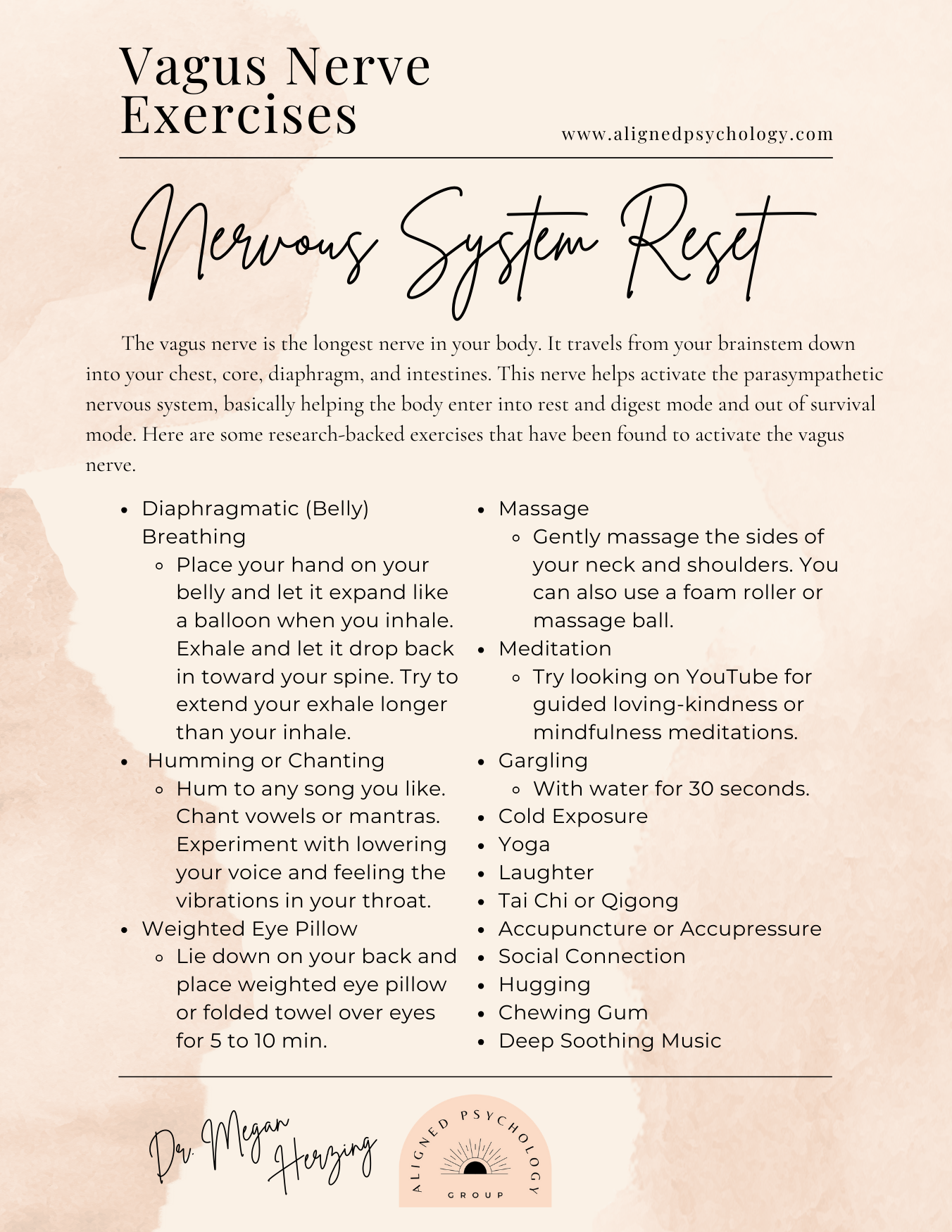Trauma Therapy Homework - Week 13
Week 13: (The Basics)
Vagus Nerve Exercises
If you've made it to Week 13 of your trauma therapy homework, first off—give yourself some credit. Healing is a journey, and every step you take is progress. This week, we're diving into something that can have a profound impact on your nervous system and overall well-being: vagus nerve exercises.
What is the Vagus Nerve?
The vagus nerve is kind of a big deal. It’s the longest nerve in your body, traveling from your brainstem all the way down into your chest, diaphragm, intestines, and core. Think of it as the body's superhighway for communication between the brain and vital organs. More importantly, it’s the main player in activating your parasympathetic nervous system—aka your "rest and digest" mode. When you stimulate the vagus nerve, you help your body shift out of fight-or-flight and into a state of calm, safety, and relaxation. This is essential for trauma recovery, as chronic stress and trauma can keep the nervous system stuck in a hypervigilant state. The good news? You can activate and strengthen this nerve through simple exercises that you can incorporate into your daily routine.
Let’s get into the exercises!

Diaphragmatic Breathing
Breathing might sound like the most basic thing ever, but how you breathe matters. Diaphragmatic breathing (or belly breathing) helps stimulate the vagus nerve by activating the diaphragm, one of the key areas the vagus nerve touches.
How to do it:
- Sit or lie down in a comfortable position.
- Place one hand or two hands on your belly.
- Inhale deeply through your nose, letting your belly expand like a balloon.
- Slowly exhale through your mouth, feeling your belly pull in toward your spine.
- Try inhaling for 5 seconds and exhaling for 7–10 seconds. Extending the exhale longer than the inhale helps calm the nervous system.
- As you breathe, imagine inhaling calm, support, or peace, and exhaling anything that no longer serves you.
Humming and Chanting
Ever noticed how good it feels to hum your favorite song? That’s because the vibrations from humming stimulate the vagus nerve, especially at the back of the throat and inner ear.
How to do it:
- Try humming for a few minutes—any song you like works.
- Chant “Om” or “Ah-Oh-M,” allowing the sound to vibrate deep in your throat.
- Experiment with lowering your voice as much as possible, feeling the vibrations.
- If you prefer, singing aloud also works wonders for vagus nerve stimulation.
Weighted Eye Pillow
Your vagus nerve also connects to your eyes. Applying gentle pressure to the eyes can stimulate relaxation and signal to your nervous system that it’s time to calm down.
How to do it:
- Lie down and place a slightly weighted eye pillow or mask over your closed eyes. You can also rest the palms of your hands on your eyes.
- Relax for 5–10 minutes while using slow, deep breathing.
- If you don’t have an eye pillow, you can use a folded towel.
This is especially helpful before bed or after a stressful day.
Meditation
Certain meditation practices are directly linked to increased vagal tone, making them powerful tools for regulating your nervous system.
Try:
- Loving-kindness meditation: Visualize sending love and compassion to yourself and others.
- Mindfulness meditation: Choose a singular focus, like your breath, a candle, watching the smoke from incense, a mantra, or a sound.
- You can find guided loving kindness or mindfulness meditations on YouTube.
Even five minutes a day can make a difference in how your nervous system responds to stress.

Massage
Massage therapy, especially around the neck and shoulders, can stimulate the vagus nerve and encourage relaxation.
How to do it:
- Gently massage the sides of your neck in slow circular motions.
- Use a foam roller or massage ball on your upper back and shoulders.
- Explore guided self-massage techniques on YouTube.
Gargling
It might sound strange, but gargling vigorously can stimulate the vagus nerve at the back of the throat.
How to do it:
- Take a sip of water and gargle loudly for 30 seconds.
- Repeat a few times throughout the day.
This simple practice helps strengthen vagal tone and supports overall nervous system health.

Cold Exposure
Cold therapy can be a game-changer for vagus nerve activation. It may sound intense, but even small doses of cold exposure can help shift your nervous system.
How to do it:
- Splash cold water on your face for 1–3 minutes.
- Hold an ice pack somewhere on your body for 20 minutes. You can always put a thin towel or sheet around an ice pack to make it sting less. Many people like the shoulders or chest.
- Add cold to your shower: you can add a minute of cold in the middle of your shower and turn it back to warm, or at the end of your shower.
It might feel shocking at first, but over time, your nervous system adapts, helping to increase resilience to stress.
Laughter
Laughter isn’t just good for the soul—it’s good for your vagus nerve, too! Genuine laughter boosts vagal tone and helps shift your nervous system into a state of joy and relaxation. Look for a funny movie, comedy special, or try laughter yoga.
Tai Chi or Qigong
These ancient movement practices incorporate slow, intentional motions and deep breathing, which naturally stimulate the vagus nerve.
Acupuncture or Acupressure
Stimulating pressure points, especially around the ears and neck, can enhance vagal tone.
Deep Listening to Music
Listening to soothing or classical music can stimulate the vagus nerve, especially music with slow, rhythmic tones.
Social Connection and Hugging
Positive social interactions, deep conversations, and hugging a loved one can activate the vagus nerve.
Chewing Gum
Chewing stimulates the muscles in the throat and jaw, indirectly engaging the vagus nerve.
Yoga
Yoga is more than just stretching—it’s a proven way to regulate the vagus nerve and enhance emotional balance. Slow, mindful movements paired with breathwork help shift the nervous system into relaxation mode.
Try:
- Gentle yin yoga, holding poses for 3–5 minutes.
- Cat-cow stretches to release tension in the spine.
- Restorative yoga, holding poses for longer and using props or pillows
Yoga helps build long-term vagal tone, making it easier for your body to recover from stress.

Bringing It All Together
There’s no one-size-fits-all when it comes to healing. Incorporating vagus nerve exercises into your routine can help create a sense of balance, safety, and calm in your body. If you’re navigating trauma recovery, these practices can serve as gentle tools to remind your nervous system that it’s okay to relax. Start small—pick one or two exercises and integrate them into your day. The more you practice, the easier it becomes for your body to shift into a state of rest and healing. Remember: Your healing is valid. Your progress is real. Keep going—you’re doing amazing.
FREE Downloadable Handouts
Click this
LINK
for free access to downloadable PDFs from the Trauma Therapy Homework Series. You’ll be directed to my Google Drive folder, where you can explore all the handouts created so far. You can choose between a digital format for easy viewing on your device or a printable version if you prefer a hard copy.
Here is a preview of this week's handout! Click the link above to get your own free pdf copy.


ABOUT THE AUTHOR
Dr. Megan
Megan Herzing PsyD, Licensed Professional Clinical Counselor, specializes in trauma therapy and creating a safe, supportive space for healing. She integrates evidence-based modalities, including EMDR, Internal Family Systems (IFS), somatic therapy, and Emotionally Focused Therapy (EFT), to address the mind-body connection and empower clients on their journey to wellness. With extensive experience treating complex PTSD, anxiety, attachment injuries, and dissociation, she believes in the power of self-compassion and authentic connection to facilitate lasting change. Drawing from her own healing journey, she brings empathy and lived experience to her work, honoring each client’s unique path toward growth and resilience.
Thank you for being part of a community of humans that deeply cares about healing.
We are honored that you stopped by and hope our resources will continue to bring value to your life.
We are accepting new clients in California, and referrals are always appreciated.












